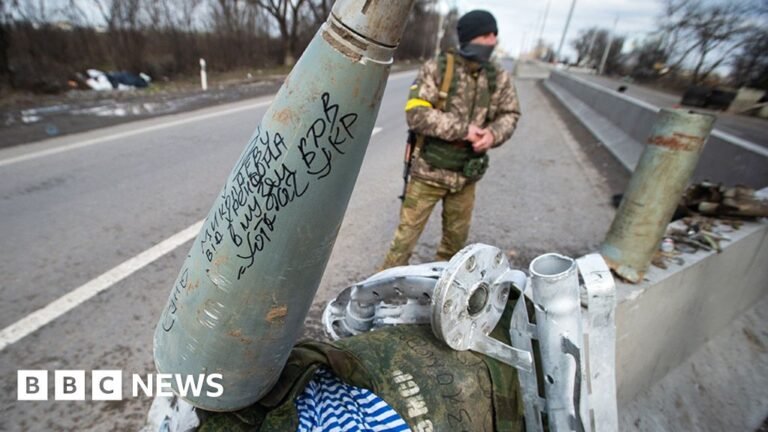- By Madeline Halpert
- BBC News, New York
See: White House addresses sending cluster munitions to Ukraine
The US will send Ukraine a cluster munitions package to help in its counter-offensive against Russia.
The White House said it was postponing the decision as long as possible because of the risk of civilian harm from unexploded ordnance.
Ukraine has been asking for weapons for months amid a shortage of ammunition.
Cluster munitions – banned in more than 100 countries – are a type of weapon that contains multiple explosive bombs called submunitions.
US President Joe Biden said in a cable TV interview that it was “a very difficult decision on my part” to send the bombs.
“I discussed it with our allies,” he told CNN, “I discussed it with our friends above the [Capitol] Hill.”
He said he decided to send the ammunition because “the Ukrainians have run out of ammunition”.
Mr Biden could face questions from allies on the matter at a NATO summit in Lithuania next week.
National Security Adviser Jake Sullivan told the daily White House briefing on Friday: “We know that cluster munitions create a risk of civilian harm from unexploded ordnance.
“This is why we are deferring the decision as long as we can.”
He added: “Ukraine will not use these bullets on some foreign land. This is their country they are defending.”
Mr Sullivan said Ukraine was running out of artillery and needed “a bridge of supplies” as the US ramped up domestic production.
“We will not leave Ukraine defenseless at any point during this conflict,” he said.
Watch: US military video shows how cluster munitions explode
The munitions are controversial because of their failure, or dud, rate, which means that unexploded bombs can remain on the ground for years and detonate later.
Mr Sullivan told reporters that the cluster munitions to be sent by America to Ukraine have a dud rate of less than 2.5%, which is described as lower than Russia’s cluster munition dud rate, which US officials say is available. between 30-40%.
In a separate news release, the Pentagon did not specify how many cluster munitions the US will send to Ukraine, but spokesman Colin Kahl said they have “hundreds of thousands available”.
US law prohibits the transfer of cluster munitions with bomblet failure rates higher than 1% – meaning that more than 1% of the weapon’s bomblets fail to explode – but President Biden is able to bypass this rule.
A United Nations investigation found that Ukraine may have used cluster bombs, although the country has denied doing so.
Early in the war, the White House was asked about allegations that Russia was using cluster bombs, and press secretary Jen Psaki said it would be a “war crime” if true.
Officials plan to send artillery shells to Ukraine, each containing 88 separate bombs, according to US media reports. They will be fired from the Howitzer artillery weapons already deployed by the Ukrainian army.
The Biden administration’s latest arms package for Ukraine is worth $800m (£626m). These include Bradley and Stryker fighting vehicles, air defense missiles and anti-mine equipment.
Human rights groups have urged Russia and Ukraine not to use cluster munitions and asked the US not to supply them.
In a statement on Friday, the Office of the United Nations High Commissioner for Human Rights once again called on countries not to use cluster bombs, arguing that they are dangerous.
“The cluster munitions scattered small bomblets over a wide area, most of which failed to detonate immediately,” said office spokeswoman Marta Hurtado. “They can kill and damage years later. That’s why use should be stopped immediately.”
Some US lawmakers have also asked the Biden administration not to send the weapons, arguing that their humanitarian costs outweigh their benefits on the battlefield.
Defense Department official Laura Cooper told Congress last month that military analysts found cluster bombs could be “useful, especially against Russian dug-in positions”.
More than 120 countries have committed to the Convention on Cluster Munitions, agreeing not to use, manufacture, transfer or store such devices.
The US, Ukraine and Russia are not parties to the agreement.
